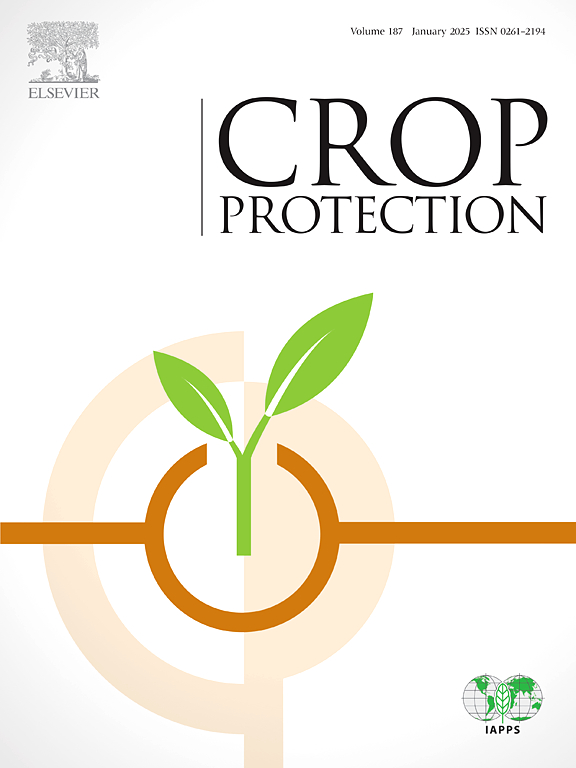Mechanism and synergy evaluation of a mixture of croton essential oil and Spirodiclofen on Phenacoccus solenopsis (Hemiptera: Pseudococcidae)
IF 2.5
2区 农林科学
Q1 AGRONOMY
引用次数: 0
Abstract
As a major invasive injurious insect, Phenacoccus solenopsis Tinsley poses a significant threat to cotton production. The presence of a wax coating on P. solenopsis impedes the efficacy of insecticides and contributes to the development of chemical pesticide resistance. Therefore, the synergistic effect and mechanism of croton essential oil (Co) and its components were investigated in combination with spirodiclofen, which has shown a superior synergistic effect on wax, to effectively manage this pest and mitigate the development of resistance. The compounds Co, α-pinene, fenchyl alcohol, and camphene exhibited favorable solubility in the wax secretions of mature female P. solenopsis, leading to a notable synergistic impact on spirodiclofen. The measured contact angles between the essential oil mixtures and beeswax were 22.27°, 26.94°, 29.72°, and 19.37°. The penetration levels of spirodiclofen were 1.65, 1.47, 1.26, and 1.45 μg, resulting in synergistic ratios of 3.51, 3.51, 3.11, and 3.37, and the inhibitory effect of increased essential oils on GST activity was 36.53%, 30.48%, 54.22% and 59.38%, respectively. The results showed that when used in combination with spirodiclofen, these compounds alone or in combination reduced the GST activity of the females, with the best synergistic effect of fenchyl alcohol with spirodiclofen, and Co and its constituents showed good synergistic effect. Thus, this method shows good potential for the development of additives and the results proved a new material source for green pest control.

巴豆精油与螺双氯芬混剂防治扶桑绵粉蚧的作用机理及协同效应评价(半翅目:假虫科)
扶桑绵粉球菌(Phenacoccus solenopsis Tinsley)是一种重要的入侵有害昆虫,对棉花生产构成严重威胁。扶桑拟虫表面蜡膜的存在阻碍了杀虫剂的药效,促进了化学农药抗性的发展。因此,研究了巴豆精油及其成分与螺双氯芬联用的协同作用及其机理,结果表明,螺双氯芬对蜡虫具有较强的协同作用,可有效防治该害虫,减缓其抗性的产生。Co、α-蒎烯、fenchyl醇和camphene等化合物在扶桑拟虫成熟雌虫的蜡分泌物中具有良好的溶解度,对螺双氯芬具有显著的协同作用。精油混合物与蜂蜡的接触角分别为22.27°、26.94°、29.72°和19.37°。螺双氯芬的渗透水平分别为1.65、1.47、1.26和1.45 μg,协同比分别为3.51、3.51、3.11和3.37,增加精油对GST活性的抑制作用分别为36.53%、30.48%、54.22%和59.38%。结果表明,当与螺双氯芬联用时,这些化合物单独或联合使用均能降低雌虫的GST活性,其中芬胆醇与螺双氯芬的协同作用效果最好,而Co及其组分具有良好的协同作用。因此,该方法具有良好的添加剂开发潜力,为绿色害虫防治提供了新的材料来源。
本文章由计算机程序翻译,如有差异,请以英文原文为准。
求助全文
约1分钟内获得全文
求助全文
来源期刊

Crop Protection
农林科学-农艺学
CiteScore
6.10
自引率
3.60%
发文量
200
审稿时长
29 days
期刊介绍:
The Editors of Crop Protection especially welcome papers describing an interdisciplinary approach showing how different control strategies can be integrated into practical pest management programs, covering high and low input agricultural systems worldwide. Crop Protection particularly emphasizes the practical aspects of control in the field and for protected crops, and includes work which may lead in the near future to more effective control. The journal does not duplicate the many existing excellent biological science journals, which deal mainly with the more fundamental aspects of plant pathology, applied zoology and weed science. Crop Protection covers all practical aspects of pest, disease and weed control, including the following topics:
-Abiotic damage-
Agronomic control methods-
Assessment of pest and disease damage-
Molecular methods for the detection and assessment of pests and diseases-
Biological control-
Biorational pesticides-
Control of animal pests of world crops-
Control of diseases of crop plants caused by microorganisms-
Control of weeds and integrated management-
Economic considerations-
Effects of plant growth regulators-
Environmental benefits of reduced pesticide use-
Environmental effects of pesticides-
Epidemiology of pests and diseases in relation to control-
GM Crops, and genetic engineering applications-
Importance and control of postharvest crop losses-
Integrated control-
Interrelationships and compatibility among different control strategies-
Invasive species as they relate to implications for crop protection-
Pesticide application methods-
Pest management-
Phytobiomes for pest and disease control-
Resistance management-
Sampling and monitoring schemes for diseases, nematodes, pests and weeds.
 求助内容:
求助内容: 应助结果提醒方式:
应助结果提醒方式:


